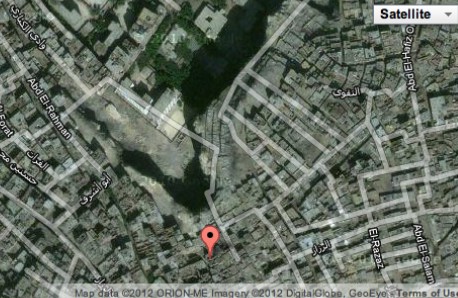
By Shetal Shah
Manshiat Nasser in the Governorate of Cairo, Egypt is a mega-slum built on government-owned land in close proximity to Cairo’s city center. Situated at the foothills of the Moqattam plateau, it sits along a wall of overhanging limestone cliffs that proved fatal for 119 residents (and possibly 300 more) during a landslide in 2008 (Al Jazeera, 2008). Along the western boundary is a single track rail line and a main highway (Dormann, 2010). It first developed in the 1960s when the government relocated garbage collectors to this area, hence the moniker ‘Rubbish City’. About 800,000–1 million people live within a total area of 850 acres (3.4 km2) and a 588 persons/acre (588 persons/.004 km2) population density. They constitute about 10% of Egypt’s 11.8 million urban slum-dwellers (Khalifah, 2011). The socio-economic strata of the community is delineated by its geography with richer merchants living near the prestigious main street and poorer residents living close to the rock cliffs (Dormann, 2010). Although traditional handicrafts and recycling exist, per capita income is US$50/month (US$1.5/day) and unemployment is high. Investments by national government and international organizations like USAID and the World Bank in water, sewage, and road infrastructure as well as in education and health programs have generated improvements in living conditions, albeit limited to the neighborhood scale and unevenly distributed within the slum (World Bank, 1991), which were also provided 2500 housing units in 1999 (Dormann, 2010). However, there is no secure tenure on land or titles to housing. This presents a major challenge. Lack of tenure discourages investment, deepens insecurity among residents, and signifies a deficit in proper administrative infrastructure (PDP, 2012). In 2005, the Cairo Governorate, to help secure land titles, established a Notarizations and Authentication Office, a pioneering effort in Egyptian informal settlements (Sanchez, 2011). However, the 2008 landslide deepened tensions when residents were promised housing they never received or were relocated to remote areas removed from employment opportunities and without new land titles, often at the force of the military. The gap between supply and demand was widened further when thirteen additional slum sections deemed unsafe by government were demolished. Exacerbating this even more is the fact that Egypt’s 40-year housing policy has benefitted the middle- and upper-class Egyptians and not the poor (Orozco, 2006). In response, slum residents, through a social network characterized by a strong sense of solidarity, banned together in 2011 and demanded their post-landslide housing. Involvement by foreign non-governmental organizations like Amnesty International also brought attention to housing conditions (Sanchez, 2011).
Developing a strategy that establishes housing finance for the poor can help to lessen the supply/demand gap. Additionally, to ensure increases in land titles, continued support and monitoring of NAO activities is highly recommended. Through a collaborative partnership between NGOs operating within the slum and resident social networks, residents can strengthen their participation in the decision-making and management processes for the above strategies and use collective pressure to ensure government follow-through.
This article is a product of Professor Shagun Mehrotra’s Global Urban Environmental Policy class. Views expressed are entirely those of the individual author.
References
Al Jazeera (2008). Hundreds buried in Cairo rockslide. Retrieved from http://www.aljazeera.com/news/middleeast/2008/09/20089611533425930.html
Dormann, F. (2010). Analysis on three Informal Settlements in Africa ‘ Khayelitsha (Cape Town), Kibera (Nairobi) and Manshiet Nasser (Cairo). Master Thesis, Universitat Leipzig and Unversitat Wein.
Google. (2012). Google Earth (Version 6.0.3.2197) [Software]. Available from http://www.earth.google.com
Khalifa, M. A. (2011) Redefining slums in Egypt: Unplanned versus unsafe areas. Habitat International Volume 35, Issue 1, pages 40’49. doi: http://dx.doi.org/10.1016/j.habitatint.2010.03.004
Orozco, J. (2006). “Squatter citizens…” New Internationalist, Jan-Feb. Retrieved from http://findarticles.com/p/articles/mi_m0JQP/is_386/ai_n16619174/pg_4/?tag=content;col1
Participatory Development Programme (PDP) in Urban Areas, Egypt. (2012). Manshiet Nasser. Retrieved from http://egypt-urban.net/pilot-areas/manshiet-nasser
Sanchez, L. (2011). Amnesty calls for an end to the forced eviction of ªslum dwellers º. Bikya Masr. Retrieved from
http://bikyamasr.com/40266/amnesty-calls-for-an-end-to-the-forced-eviction-of-%E2%80%98slumdwellers%E2%80%99/
World Bank. (1991). Urban Policy and economic development. An agenda for the 1990s. World Bank Policy Paper. Washington, DC: World Bank, p5 for a detailed discussion on slum upgrades as generating local impact rather than addressing the broader issues of urban development.